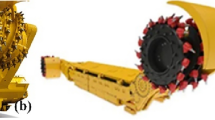Abstract
Poor performance in coal loading of thin coal shearer is the main reason affecting thin coal mining efficiency. In the paper, the development of thin coal shearer coal loading performance was summarized and the lack of the related researches was pointed out. According to the working features of dip angle of thin coal shearer at the different working faces, a simplified model of drum coal loading was set up. The influence rules of dip angle on drum pushing and drum ejection coal loading performance were studied by discrete element method (DEM) simulations and the prime factors of drum coal loading rate significantly influenced by dip angle were identified. In addition, according to the poor drum coal loading rate, the improvement suggestions were proposed, and verified through DEM simulation.
Similar content being viewed by others
References
Hekimoglu OZ, Ozdemir L (2004) Effect of angle of wrap on cutting performance of drum shearers and continuous miners. Min Technol 113:118–122
Bo Y. Numerical simulation of continuous miner rock cutting process, Ph.D. Thesis, West Virginia University, West Virginia, USA, (2005).
Yang DL, Li JP, Wang LP, Gao KD, Tang YH, Wang YX (2015) Experimental and theoretical design for decreasing wear in conical picks in rotation-drilling cutting process. Int J Adv Manuf Technol. doi:10.1007/s00170-014-6472-5
Brijes M. Analysis of cutting parameters and heat generation on bits of a continuous miner using numerical and experimental approach. Michigan: ProQuest, 2007.
Brooker CM. Theoretical and practical aspects of cutting and loading by shearer drums, Colliery Guardian Coal International, April, 41–50(1979).
Ludlow J, Jankowski RA (1984) Use lower shearer drum speed to achieve deeper coal cutting. Min Eng 36:251–255
Peng SS, Chang HS (1984) Longwall mining. John Wiley and Sons, New York
Hurt KG, Mcstravick FG (1988) High performance shearer drum design. Colliery Guardian 236:425–429
Morris CJ. The design of shearer drums with the aid of a computer, The Mining Engineer, November, 289–295(1980).
Ayhan M. Investigation into the cutting and loading performance of drum shearers in OAL mine. M.Sc. Thesis, The University of Hacettepe, Institution of Science. Ankara, Turkey. (1994).
Ayhan M, Eyyuboglu EM (2006) Comparison of globoid and cylindrical shearer drums’ loading performance. Journal of the South African Institute of Mining and Metallurgy 106:51–56
Li XH, Mu YC, Shi N, Tang RP, Yao TY (2012) Parameter optimization design of screw drum for drum shearer based on PSO-GACA algorithm. Journal of Guangxi University (Nat Sci Ed) 37(3):561–566
Liu SY, Du CL, Zhang JJ, Jiang H (2011) Parameters analysis of shearer drum loading performance. Min Sci Technol 21(5):621–624
Cundall PA. Computer model for simulating progressive large scale movements in blocky rock systems. In Proceedings of the Symposium of the International Society of Rock Mechanics (Nancy, France, 1971), Vol. 1, Paper No. II-8, 1971.
Cundall PA, Strack OA (1979) Discrete numerical model for granular assemblies. Geotechnique 29(1):47–65
Cundall PA (1988) Formulation of a three-dimensional distinct element model—part I. A scheme to detect and represent contacts in a system composed of many polyhedral blocks. Int J Rock Mech, Min Sci & Geomech Abstr 25(3):107–116
Hart R, Cundall PA, Lemos J (1988) Formulation of a three-dimensional distinct element model part II. Mechanical calculations for motion and interaction of a system composed of many polyhedral blocks. Int. J. Rock Mech., Min. Sci. & Geomech. Abstr. 25(3):117–125
Campbell CS (1990) Rapid granular flows. Annu Rev Fluid Mech 22:57–92
Walton OR. Numerical simulation of inelastic frictional particle–particle interaction, in Particulate two-phase flow, CH. 25, pp. 884–911. M.C. Roco, Ed. Stoneham: Butterworth-Heinemann, 1993.
Barker GC (1994) Computer simulations of granular materials in Granular matter: an interdisciplinary approach, pp.35–83, a. Mehta, Ed. Springer-Verlag, New York
Shimizu Y, Cundall PA (2001) Three-dimensional DEM simulation of bulk handling screw conveyors. J Eng Mech 127(9):864–872
Owen PJ, Cleary PW (2009) Prediction of screw conveyor performance using the discrete element method (DEM). Powder Technol 193(3):274–288
Owen PJ and Cleary PW. Screw conveyor performance: comparison of discrete element modelling with laboratory experiments, in Inderscience Publishers seventh International Conference on CFD in the Minerals and Process Industries, pp.1–7(2009).
Li HY. Simulation research on the loading performance of vertical screw conveyor using DEM, M.S. dissertation, Taiyuan University of Science and Technology, Taiyuan, Shijiazhuang, China, 2011.
Fernandez JW, Cleary PW, McBride W (2011) Effect of screw design on hopper drawdown of spherical particles in a horizontal screw feeder. Chem Eng Sci 66(15):5585–5601
Mcbride W, Cleary PW (2009) An investigation and optimization of the ‘OLDS’ elevator using discrete element modeling. Powder Technol 193(3):216–234
Moysey PA, Thompson MR (2005) Modelling the solids inflow and solids conveying of single-screw extruders using the discrete element method. Powder Technol 153(2):95–107
Itasca Consulting Group, Inc. PFC3D (Particle Flow Code in 3 Dimensions), Version 4.0. Minneapolis, USA, 2000.
Gao KD, Du CL, Fu L, Jiang HX (2014) Effect of mining face angle on drum loading performance using discrete element method. International Journal of Earth Sciences and Engineering 7(1):41–51
Author information
Authors and Affiliations
Corresponding author
Rights and permissions
About this article
Cite this article
Gao, K., Wang, L., Du, C. et al. Research on the effect of dip angle in mining direction on drum loading performance: a discrete element method. Int J Adv Manuf Technol 89, 2323–2334 (2017). https://doi.org/10.1007/s00170-016-9251-7
Received:
Accepted:
Published:
Issue Date:
DOI: https://doi.org/10.1007/s00170-016-9251-7




